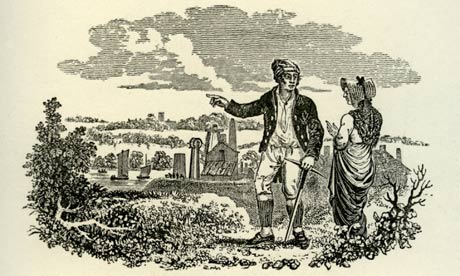
May 2012 is the bicentenary of Thomas Bewick moving across the Tyne from Newcastle to live (and, 16 years later, die) in Gateshead.
The anniversary is being marked by an exhibition, "Bewick in Gateshead", at the St Mary's heritage centre – the Grade I listed partly Norman former church that stands by the south tower of the Tyne Bridge.
Bewick was born in 1753 at Cherryburn in Northumberland, a dozen miles upstream from Gateshead. While producing his masterpieces such as A General History of Quadrepeds or The History of British Birds he lived virtually all his life within sight or sound of the river. Although, like his fellow great Northumberland artist John Martin, born a few miles further up the Tyne a few decades later, he spent some time in London, unlike Martin, he quickly returned to his home turf. According to him:
"I would rather be herding sheep on Mickley bank top than to remain in London, although for doing so I was to be made the premier of England."
And he didn't like the people down there much either, saying Londoners were "impudent" - when accosted by importunate cockney street vendors he would put on an excessively thick Northumberland accent and ask if they knew "Willy Eltringham o' Hall-Yards or auld laird Newton o' Mickley", which usually discouraged them.
He was a true lover of the countryside, and it is from that passion that the accuracy of his depictions at least partly springs. In order to get his famous view of the Chillingham Bull, he spent hours crawling on hands and knees through boggy countryside to get a side view of the elusive wild bull. He was also surprisingly versatile – as well as his famous birds and beasts, he also designed banknotes, and bar bills, including publicity leaflets for local inns.
In a much quieter way, he could be as acute and as eloquent a critic of human brutality as Goya. Many of his works touch on cruelty to children or animals, and, living through the Napoleonic wars, he was an early proponent of pacifism – as he put it
"I had reasoned myself into a detestation of war, its cruelty, its horrors, and the superlative wickedness of the authors of it… It is foreign to my purpose to enlarge upon this subject: I must leave that to others; and there is an abundant scope to dilate upon, and to depicture, the horrors of war in their true colours."
The other great artist-naturalist, John James Audubon, an admirer who came to Gateshead to visit Bewick the year before he died, said of him:
"Look at his tail-pieces, Reader, and say if you ever saw so much life represented before, from the Glutton, who precedes the Great Black-backed Gull, to the youngsters flying their kite; the disappointed sportsman, who, by killing a magpie, has lost a woodcock ; the horse endeavouring to reach the water ; the bull roaring near the stile ; or the poor beggar attacked by the rich man's mastiff. As you turn each successive leaf, from beginning to end of his admirable books, scenes calculated to excite your admiration everywhere present themselves. Assuredly you will agree with me in thinking that in his peculiar path none have equalled him."
Bewick's house in Gateshead was demolished and a post office built on the site in 1887. The post office closed a few years ago and the building now houses the Workplace Gallery. Bewick used regularly to cross the river to see his friends back in Newcastle. He was a regular at the Sign of the Cannon pub, where he was a member of a book club and where he used "to get my pint of ale & a cake & to hear the News & to have a bit of chat."
Although semi-retired after a serious illness by the time he moved to Gateshead, Bewick never stopped work. His illustrations to Aesop's Fables came out in 1818. Also included in this exhibition is what his daughter Jane thought was probably his final work – a view of a funeral cortege at Ovingham church, where he himself was to be buried shortly afterwards, with a rowing boat heading down the Tyne in the foreground. Bewick in Gateshead is at St Mary's heritage centre, Gateshead, until May 31.

